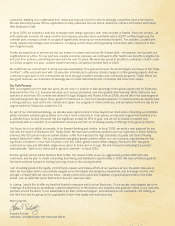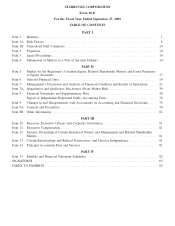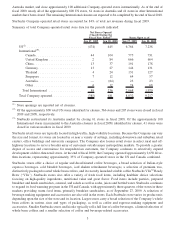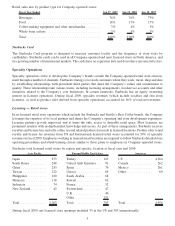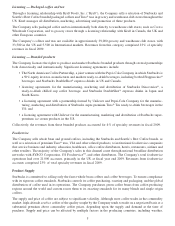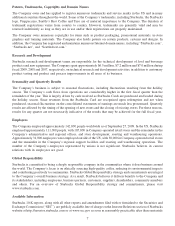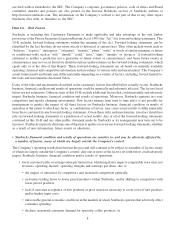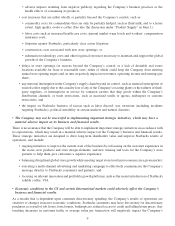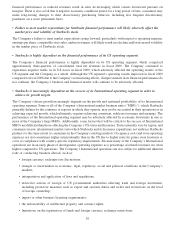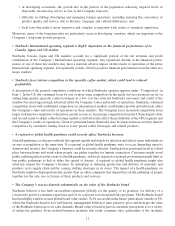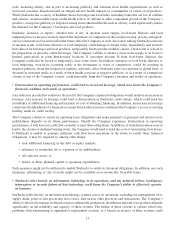Starbucks 2009 Annual Report Download - page 14
Download and view the complete annual report
Please find page 14 of the 2009 Starbucks annual report below. You can navigate through the pages in the report by either clicking on the pages listed below, or by using the keyword search tool below to find specific information within the annual report.political and economic conditions. In addition, green coffee prices have been affected in the past, and may be
affected in the future, by the actions of certain organizations and associations that have historically attempted to
influence prices of green coffee through agreements establishing export quotas or by restricting coffee supplies.
To help ensure sustainability and future supply of high-quality green coffees and to reinforce the Company’s
leadership role in the coffee industry, Starbucks operates Farmer Support Centers in Costa Rica and Rwanda. The
Farmer Support Centers are staffed with agronomists and sustainability experts who work with coffee farming
communities to promote best practices in coffee production designed to improve both coffee quality and yields.
The Company buys coffee using fixed-price and price-to-be-fixed purchase commitments, depending on market
conditions, to secure an adequate supply of quality green coffee. As of September 27, 2009, the Company had
$238 million of purchase commitments which, together with existing inventory, is expected to provide an adequate
supply of green coffee through fiscal 2010.
The Company depends upon its relationships with coffee producers, outside trading companies and exporters for its
supply of green coffee. The Company believes, based on relationships established with its suppliers, the risk of non-
delivery on such purchase commitments is remote.
In addition to coffee, the Company also purchases significant amounts of dairy products, particularly fluid milk, to
support the needs of its Company-operated retail stores. The Company’s highest volume of dairy purchases are in
the US, Canada and the UK. For these markets, Starbucks purchases substantially all of its fluid milk requirements
from six dairy suppliers. The Company believes, based on relationships established with these suppliers, the risk of
non-delivery of sufficient fluid milk to support these retail businesses is remote.
Products other than whole bean coffees and coffee beverages sold in Starbucks retail stores are obtained through a
number of different channels. Beverage ingredients other than coffee and milk, including leaf teas and the
Company’s selection of ready-to-drink beverages, are purchased from several specialty suppliers, usually under
long-term supply contracts. Food products, such as fresh pastries, breakfast sandwiches and lunch items, are
purchased from national, regional and local sources. Coffee-making equipment, such as drip and coffee press
coffeemakers, espresso machines and coffee grinders, are generally purchased directly from their manufacturers.
Beverage-related accessories, including items bearing the Company’s logos and trademarks, are produced and
distributed through contracts with a number of different suppliers. The Company also purchases a broad range of
paper and plastic products, such as cups and cutlery, from several companies to support the needs of its retail stores
as well as its manufacturing and distribution operations. The Company believes, based on relationships established
with these suppliers and manufacturers, the risk of non-delivery is remote.
Competition
The Company’s primary competitors for coffee beverage sales are quick-service restaurants and specialty coffee
shops. In almost all markets in which the Company does business, there are numerous competitors in the specialty
coffee beverage business, and management expects this situation to continue. The Company believes that its
customers choose among specialty coffee retailers primarily on the basis of product quality, service and conve-
nience, as well as price. Starbucks has been experiencing greater direct competition from large competitors in the
US quick-service restaurant sector and continues to face competition from well-established companies in many
International markets and in the US ready-to-drink coffee beverage market.
The Company’s whole bean coffees and ground packaged coffees compete directly against specialty coffees sold
through supermarkets, club stores and specialty retailers. The Company’s whole bean coffees, its coffee beverages,
and its recently launched soluble coffee VIA, compete indirectly against all other coffees on the market. Starbucks
specialty operations face significant competition from established wholesale and mail order suppliers, some of
whom have greater financial and marketing resources than the Company.
Starbucks also faces competition from both restaurants and other specialty retailers for prime retail locations and
qualified personnel to operate both new and existing stores.
6


